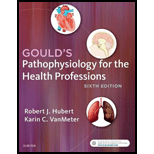
Concept explainers
(1)
To explain: The purpose of surfactant.
Concept introduction: The mechanism of oxygen transport from the air into the blood and carbon dioxide removal from the blood occurs through respiratory system. There are two anatomic areas in the respiratory system. They are as follows:
- Upper respiratory tract
- Lower respiratory tract
The upper respiratory tract consists of air passageways that include nasal cavity, larynx, pharynx, and trachea. The lower respiratory tract includes the trachea, bronchial tree, and the lungs.
(2)
To explain: The purpose of the ribs.
Concept introduction: The mechanism of oxygen transport from the air into the blood and carbon dioxide removal from the blood occurs through respiratory system. There are two anatomic areas in the respiratory system. They are as follows:
- Upper respiratory tract
- Lower respiratory tract
The upper respiratory tract consists of air passageways that include nasal cavity, larynx, pharynx, and trachea. The lower respiratory tract includes the trachea, bronchial tree, and the lungs.
(3)
To explain: The purpose of the respiratory membrane.
Concept introduction: The mechanism of oxygen transport from the air into the blood and carbon dioxide removal from the blood occurs through respiratory system. There are two anatomic areas in the total respiratory system. They are as follows:
- Upper respiratory tract
- Lower respiratory tract
The upper respiratory tract consists of air passageways that include nasal cavity, larynx, pharynx, and trachea. The lower respiratory tract includes the trachea, bronchial tree, and the lungs.
(4)
To explain: The purpose of diaphragm.
Concept introduction: The mechanism of oxygen transport from the air into the blood and carbon dioxide removal from the blood occurs through respiratory system. There are two anatomic areas in the respiratory system. They are as follows:
- Upper respiratory tract
- Lower respiratory tract
The upper respiratory tract consists of air passageways that include nasal cavity, larynx, pharynx, and trachea. The lower respiratory tract includes the trachea, bronchial tree, and the lungs.
(5)
To explain: The purpose of alveolar macrophage.
Concept introduction: The mechanism of oxygen transport from the air into the blood and carbon dioxide removal from the blood occurs through respiratory system. There are two anatomic areas in the respiratory system. They are as follows:
- Upper respiratory tract
- Lower respiratory tract
The upper respiratory tract consists of air passageways that include nasal cavity, larynx, pharynx, and trachea. The lower respiratory tract includes the trachea, bronchial tree, and the lungs.
(6)
To explain: The purpose of the bronchial artery.
Concept introduction: The mechanism of oxygen transport from the air into the blood and carbon dioxide removal from the blood occurs through respiratory system. There are two anatomic areas in the respiratory system. They are as follows:
- Upper respiratory tract
- Lower respiratory tract
The upper respiratory tract consists of air passageways that include nasal cavity, larynx, pharynx, and trachea. The lower respiratory tract includes the trachea, bronchial tree, and the lungs.
Want to see the full answer?
Check out a sample textbook solution
Chapter 13 Solutions
Gould's Pathophysiology for the Health Professions, 6e
 Phlebotomy EssentialsNursingISBN:9781451194524Author:Ruth McCall, Cathee M. Tankersley MT(ASCP)Publisher:JONES+BARTLETT PUBLISHERS, INC.
Phlebotomy EssentialsNursingISBN:9781451194524Author:Ruth McCall, Cathee M. Tankersley MT(ASCP)Publisher:JONES+BARTLETT PUBLISHERS, INC. Gould's Pathophysiology for the Health Profession...NursingISBN:9780323414425Author:Robert J Hubert BSPublisher:Saunders
Gould's Pathophysiology for the Health Profession...NursingISBN:9780323414425Author:Robert J Hubert BSPublisher:Saunders Fundamentals Of NursingNursingISBN:9781496362179Author:Taylor, Carol (carol R.), LYNN, Pamela (pamela Barbara), Bartlett, Jennifer L.Publisher:Wolters Kluwer,
Fundamentals Of NursingNursingISBN:9781496362179Author:Taylor, Carol (carol R.), LYNN, Pamela (pamela Barbara), Bartlett, Jennifer L.Publisher:Wolters Kluwer, Fundamentals of Nursing, 9eNursingISBN:9780323327404Author:Patricia A. Potter RN MSN PhD FAAN, Anne Griffin Perry RN EdD FAAN, Patricia Stockert RN BSN MS PhD, Amy Hall RN BSN MS PhD CNEPublisher:Elsevier Science
Fundamentals of Nursing, 9eNursingISBN:9780323327404Author:Patricia A. Potter RN MSN PhD FAAN, Anne Griffin Perry RN EdD FAAN, Patricia Stockert RN BSN MS PhD, Amy Hall RN BSN MS PhD CNEPublisher:Elsevier Science Study Guide for Gould's Pathophysiology for the H...NursingISBN:9780323414142Author:Hubert BS, Robert J; VanMeter PhD, Karin C.Publisher:Saunders
Study Guide for Gould's Pathophysiology for the H...NursingISBN:9780323414142Author:Hubert BS, Robert J; VanMeter PhD, Karin C.Publisher:Saunders Issues and Ethics in the Helping Professions (Min...NursingISBN:9781337406291Author:Gerald Corey, Marianne Schneider Corey, Cindy CoreyPublisher:Cengage Learning
Issues and Ethics in the Helping Professions (Min...NursingISBN:9781337406291Author:Gerald Corey, Marianne Schneider Corey, Cindy CoreyPublisher:Cengage Learning





